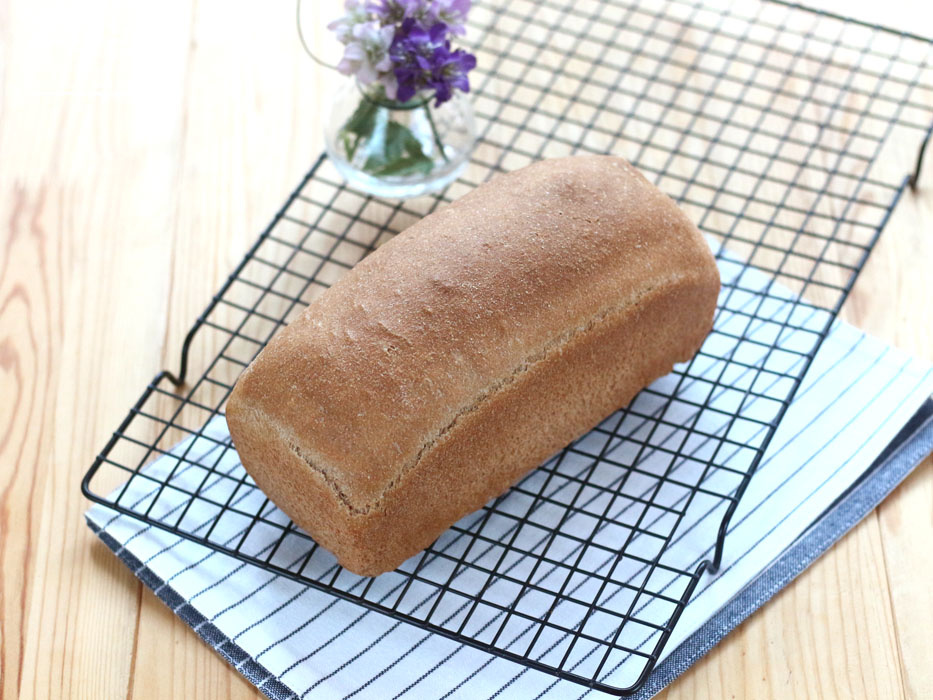Soft 100% Whole Wheat Bread (Summer Version)
Achieve Soft and Delicious 100% Whole Wheat Bread Even in Warm Weather!

This is a summer version of the popular 100% whole wheat bread recipe from last year. We’ve refined the original recipe, which was designed for winter, to prevent over-proofing in warmer seasons. By reducing the amount of yeast and using room-temperature water, this version yields a wonderfully soft loaf that is much more foolproof. While it might have a slightly less dramatic rise than the winter version, the deep, rich flavor of whole wheat and its moist texture remain exceptional, offering both health benefits and delicious taste. This guide provides detailed steps and temperature tips, making it perfect even for beginner bakers. Bake a wholesome and tasty bread for your family today!
Equipment- 1 standard loaf pan (for milk bread)
Sponge (Pre-ferment)- 150g Bobs Red Mill Whole Wheat Flour
- 210g Room temperature water
- 18g Honey
- 1 tsp Instant dry yeast
Main Dough- 150g Bobs Red Mill Whole Wheat Flour
- 1 tsp Salt
- 2 Tbsp Grapeseed oil
- 1.5 tsp Lemon juice
- 1-2 Tbsp Room temperature water (for adjusting dough consistency)
- 150g Bobs Red Mill Whole Wheat Flour
- 210g Room temperature water
- 18g Honey
- 1 tsp Instant dry yeast
Main Dough- 150g Bobs Red Mill Whole Wheat Flour
- 1 tsp Salt
- 2 Tbsp Grapeseed oil
- 1.5 tsp Lemon juice
- 1-2 Tbsp Room temperature water (for adjusting dough consistency)
Cooking Instructions
Step 1
First, let’s prepare the sponge (pre-ferment). In room temperature water (around 28°C or 82°F), dissolve the honey completely. Note: The day this recipe was developed was very humid (26.4-27°C / 79.5-80.6°F with 82% humidity), so keep this environment in mind when monitoring your dough.

Step 2
Add the instant dry yeast to the water and honey mixture and let it sit for about 5 minutes to activate. Once the yeast is bubbly or has settled, stir gently to combine.

Step 3
Add the 150g of Bobs Red Mill whole wheat flour to the mixture. Stir with a spatula or dough scraper until no dry flour remains and it forms a shaggy dough. We are using Bobs Red Mill whole wheat flour for this recipe.

Step 4
The final temperature of the sponge dough was 30.2°C (86.4°F). If your sponge’s temperature is higher, fermentation will proceed faster than this recipe’s timeline; if it’s lower, it will be slower. Adjust accordingly.

Step 5
Allow the sponge to ferment at room temperature (around 26-27°C or 79-81°F with 82% humidity) for about 42-45 minutes, or until it has tripled in volume. Be mindful, as high temperatures and humidity can easily lead to over-proofing, so watch it closely.

Step 6
Transfer the fermented sponge to your stand mixer bowl. Add the 150g of whole wheat flour and 1 tsp of salt for the main dough. Mix on low speed (e.g., speed 1 on a Kenwood mixer) for about 3-4 minutes, or until the ingredients just come together into a shaggy mass.

Step 7
Add the 2 Tbsp of grapeseed oil and 1.5 tsp of lemon juice to the mixer. Continue mixing until well incorporated. Check the dough’s consistency; if it seems too dry, add 1-2 Tbsp of room temperature water to achieve a soft, slightly sticky dough. (I didn’t need to add extra water on the humid day I baked). The lemon juice is added to aid fermentation, not primarily for flavor. Orange juice or zest can be substituted if lemon juice is unavailable.

Step 8
If you added water and the dough became a bit too wet, you can add about 1 Tbsp of whole wheat flour and mix briefly, or simply scrape the dough together into a cohesive ball using a spatula without adding more flour. Let the dough rest for 5 minutes.

Step 9
After the 5-minute rest, continue kneading the dough on a medium speed (e.g., speed 2) for about 5-8 minutes. The dough is ready when it becomes smooth, shiny, and pulls away cleanly from the sides of the bowl, forming a cohesive ball. (I kneaded for 6 minutes on speed 2).

Step 10
The final dough temperature after kneading was 32.4°C (90.3°F), indicating a well-developed dough.

Step 11
Place the dough in a lightly oiled bowl, cover, and let it rest at room temperature (around 26-27°C or 79-81°F) for 15-20 minutes. This is the bulk fermentation rest.

Step 12
Due to the warm ambient and dough temperatures, the dough will likely double in size during this relatively short rest period.

Step 13
Once the bulk fermentation rest is complete, turn the dough out onto a lightly floured surface. Gently press it into an oval shape.

Step 14
Roll the dough up into a tight cylinder, starting from the top edge and rolling downwards. Handle the dough gently during shaping to maintain the air incorporated during fermentation.

Step 15
Place the shaped dough seam-side down into your greased loaf pan. Gently press down on the dough with the back of your hand to ensure it fills the bottom of the pan. Cover and let it proof at room temperature (26-27°C or 79-81°F) until the dough reaches the top of the pan.

Step 16
The final proofing stage is critical, especially when preheating the oven, as it’s the easiest time for the dough to over-proof. In my experience at 26-27°C, about 10 minutes of proofing brings the dough halfway up the pan. At this point, I start preheating the oven to 180°C (350°F). After another 10-15 minutes of proofing, when the dough has reached the rim of the pan, it’s ready to bake. The total final proofing time at this temperature is usually around 20-25 minutes. Bake in the preheated oven at 180°C (350°F) for 30-35 minutes. Once baked, carefully remove the bread from the pan and let it cool completely on a wire rack before slicing.




